Burgmüller, Johann Friedrich Franz : 25 Etudes faciles et progressives, conposées et doigtées expressément pour l'étendue des petites mains L'hirondelle Op.100-24
Work Overview
Genre:etude
Total Playing Time:1 min 00 sec
Copyright:Public Domain
Commentary (3)
Author : Sato, Takashi
Last Updated: January 31, 2022
[Open]
Author : Sato, Takashi
This piece depicts swallows flying high into the sky and returning close to the ground, using wide arpeggios that involve hand crossing. Among the 25 etudes, this one is exceptionally challenging technically and is often skipped; however, please do try it using the practice methods introduced here. The tempo of quarter note = 138, as indicated by the composer's "non troppo," is not excessively fast, implying a speed that allows the right hand to play without rushing. Instead of viewing the entire piece as a single arpeggio, consider it divided into three voices: bass, accompaniment, and soprano, and try varying the timbre of each.
Performance Points (Original Tempo: Quarter Note = 138)
First, try playing the right hand as chords and focus solely on the left hand's leaps and the differentiation between the two voices (bass and soprano) (Musical Example 1). The bass is in eighth notes, while the soprano is in sixteenth notes. The soprano notes are mostly on weak beats, and instead of dropping them with the momentum of the leap, you need to prepare them close to the keys before playing. Also pay attention to the legato in measures 7 and 8, among others. Next, practice the ascending and descending arpeggios separately (Musical Example 2). Make sure to grasp the distance of the jump from the bass.
(From "Burgmüller 25 Etudes" (NS70) by To-on Publications)
Author : Iida, Arisa
Last Updated: March 15, 2018
[Open]
Author : Iida, Arisa
Musical example provided by: Ongaku no Tomo Sha
Author : Ooi, Kazurou
Last Updated: May 23, 2019
[Open]
Author : Ooi, Kazurou
This piece features the melody line played by crossing the hands, a technique common in many works (e.g., Liszt: Un Sospiro). The author attempted to play this piece and found it challenging. While tempo certainly plays a role, today I would like to share some special fingerings for everyone. These fingerings are feasible for students who can reach an octave. Please use them as a reference.
Special Fingerings
- Bar 1: The two melody notes on beats 2 and 4 are played with the right hand. In this case, use finger 5, and for the preceding arpeggios on beats 1 and 3, use fingers 1-2-4.
- Bar 2: Beat 2 is played with the right hand; beats 3 and 4 are played with the left hand.
- Bar 3: Both beat 2 and beat 4 are played with the left hand.
- Bar 4: Beats 2 and 3 are played with the left hand; beat 4 is played with the right hand.
- Bars 5-6: Same as Bars 1-2.
- Bar 7: Beats 2, 3, and 4 are all played with the left hand.
- Bar 8: Beat 1 is played with the right hand.
- Bars 9-16: Same as Bars 1-8.
- Bar 17: Beats 2 and 4 are played with the right hand.
- Bar 18: All notes are played with the left hand.
- Bars 19-20: Same as Bars 18-19.
- Bar 21: All notes are played with the right hand.
- Bar 22: Beat 2 is played with the right hand; the rest are played with the left hand.
- Bar 23: Played with the left hand.
- Bar 25: All notes are played with the left hand.
- Bar 27: All notes are played with the left hand.
- Bar 29: From beat 2 to the first note of beat 3, all notes are played with the right hand. From the second note of beat 3 to the first note of beat 4, all notes are played with the left hand. From the second note of beat 4 to the first note of Bar 30, all notes are played with the right hand.
Arrangements & Related Works(2)
PTNA & Partner Channel Videos(19items) View More
Sheet MusicView More
Scores List (24)

(株)東音企画(バスティン)

(株)東音企画(バスティン)

(株)東音企画(バスティン)

(株)全音楽譜出版社

(株)ドレミ楽譜出版社

(株)音楽之友社

KMP(ケイ・エム・ピー) ケイエムピー

(株)ドレミ楽譜出版社

ハンナ(ショパン)

(株)ヤマハミュージックエンタテインメントホールディングス

デプロMP

(株)ドレミ楽譜出版社

(株)全音楽譜出版社

(株)ドレミ楽譜出版社

カワイ出版

カワイ出版

デプロMP

(株)ヤマハミュージックエンタテインメントホールディングス

デプロMP

(株)音楽之友社

(株)共同音楽出版社

Neil A. Kjos Music Company



















